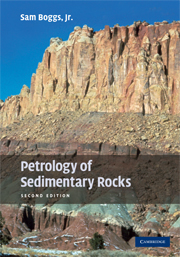Book contents
- Frontmatter
- Contents
- Preface
- Part I Principles
- Part II Siliciclastic sedimentary rocks
- Part III Carbonate sedimentary rocks
- Chapter 9 Limestones
- Chapter 10 Dolomites
- Chapter 11 Diagenesis of carbonate rocks
- Part IV Other chemical/biochemical sedimentary rocks and carbonaceous sedimentary rocks
- References
- Index
- References
Chapter 9 - Limestones
from Part III - Carbonate sedimentary rocks
Published online by Cambridge University Press: 05 June 2012
- Frontmatter
- Contents
- Preface
- Part I Principles
- Part II Siliciclastic sedimentary rocks
- Part III Carbonate sedimentary rocks
- Chapter 9 Limestones
- Chapter 10 Dolomites
- Chapter 11 Diagenesis of carbonate rocks
- Part IV Other chemical/biochemical sedimentary rocks and carbonaceous sedimentary rocks
- References
- Index
- References
Summary
Introduction
As indicated in Chapter 1, carbonate rocks make up about one-fifth to one-quarter of all sedimentary rocks in the stratigraphic record. They occur in many Precambrian assemblages and in all geologic systems from the Cambrian to the Quaternary. Both limestone and dolomite are well represented in the stratigraphic record. Dolomite is the dominant carbonate rock in Precambrian and Paleozoic sequences, whereas limestone is dominant in carbonate units of Mesozoic and Cenozoic age (Ronov, 1983).
On the basis of their abundance alone, about the same as that of sandstones, carbonate rocks are obviously an important group of rocks. They are important for other reasons as well. They contain much of the fossil record of past life forms, and they are replete with structures and textures that provide invaluable insight into environmental conditions of the past. Aside from their intrinsic value as indicators of Earth history, they also have considerable economic significance. They are used for a variety of agricultural and industrial purposes, they make good building stone, they serve as reservoir rocks for more than one-third of the world's petroleum reserves, and they are hosts to certain kinds of ore deposits such as epigenetic lead and zinc deposits.
The microscopic study of carbonate rocks dates back to the beginning of petrographic analysis. The science of petrography was initiated by an English geologist named Henry Clifton Sorby, who began petrographic analysis in about 1851 with the study of limestones.
- Type
- Chapter
- Information
- Petrology of Sedimentary Rocks , pp. 313 - 381Publisher: Cambridge University PressPrint publication year: 2009



